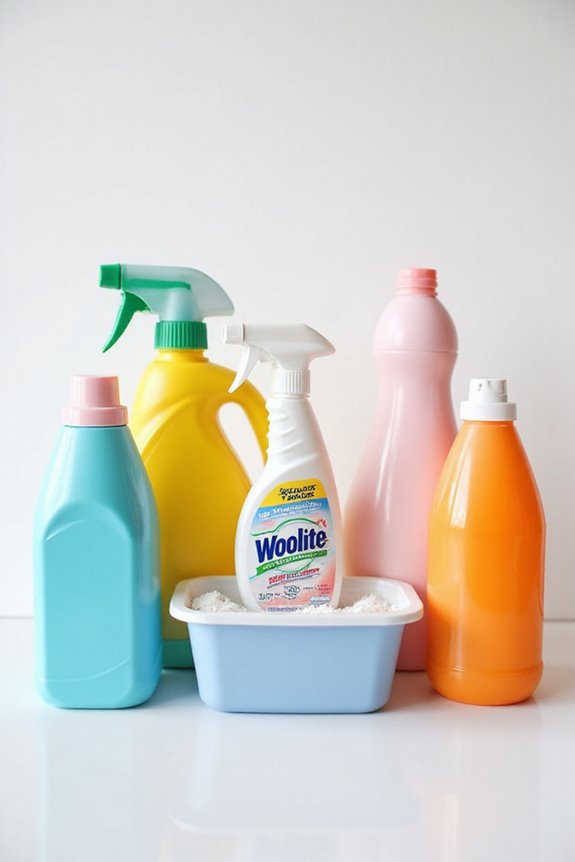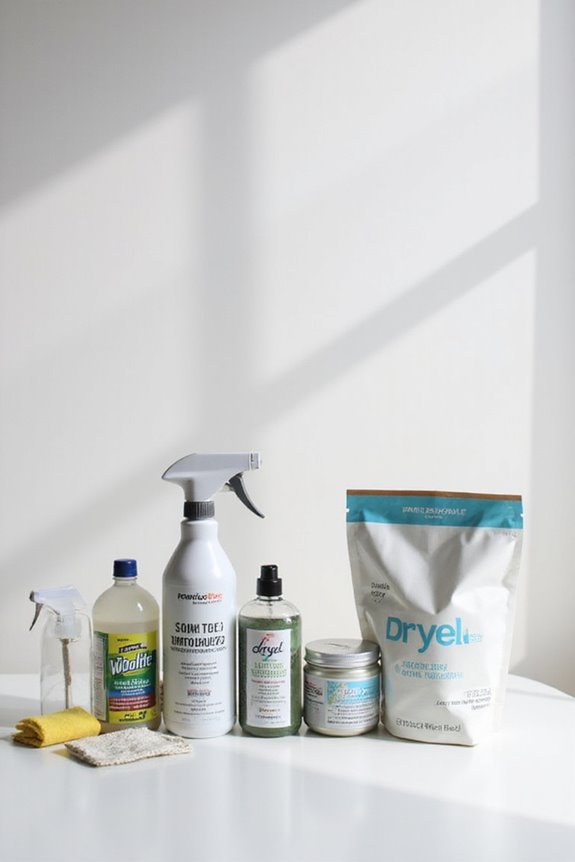When it comes to stain remover safety for colored clothes, we should choose enzyme-based or oxygen-based options. They lift stains without fading colors. Remember to dab gently, test a hidden spot first, and wash promptly in cold water. Avoid bleach and harsh scrubbing. And hey, a vinegar-water mix can work wonders, too! If we follow these tips, our clothes stay vibrant. Stick around, and we’ll share more tricks for tackling those tricky stains!
Key Takeaways
- Use bleach-free stain removers specifically designed for colored fabrics to prevent fading.
- Always test a small, hidden area for colorfastness before applying any stain remover.
- Avoid mixing different cleaning products to prevent harmful chemical reactions.
- Gently dab stains instead of scrubbing to minimize damage to the fabric.
- Rinse thoroughly after stain removal to eliminate any residual chemicals from the fabric.
Types of Stain Removers Safe for Colored Fabrics
When it comes to keeping our colored clothes looking fresh, choosing the right stain remover can feel a bit overwhelming. Thankfully, we have options! Enzyme-based stain removers are fantastic for breaking down protein and fat stains without bleaching our favorite colors. These work well on organic stains like blood and sweat, but we should always check for stain compatibility with our fabrics. Oxygen-based removers are another great choice; they lift stains without fading colors, making them perfect for coffee or wine mishaps. Plus, color-safe liquid formulas protect dye while boosting odor removal. We’ve found that natural options, like vinegar-enhanced removers, can tackle stains effectively too. Additionally, many eco-friendly options are available that prioritize both safety and effectiveness for your colored fabrics. So, let’s keep our clothes vibrant and stain-free!
Application Guidelines for Effective Stain Removal
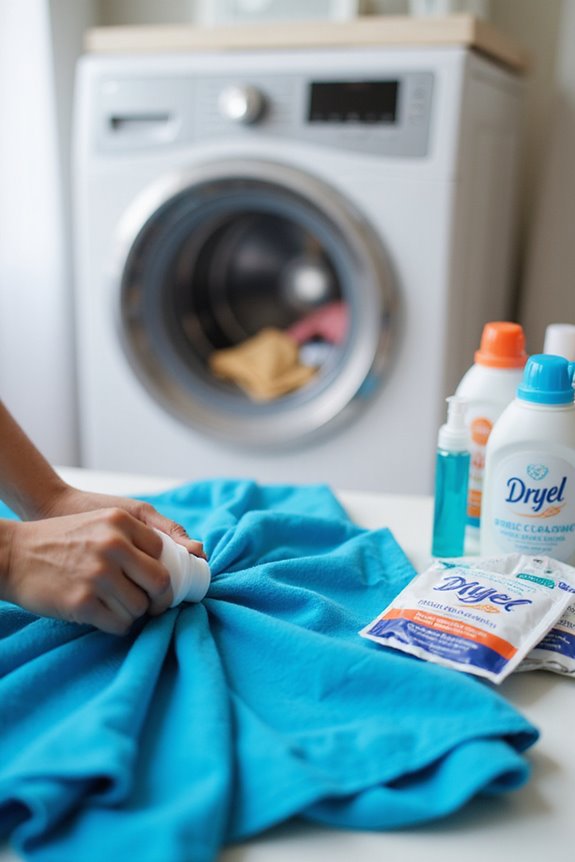
Choosing the right stain remover is just the beginning; knowing how to apply it effectively is just as important. First, we should act fast—applying the remover as soon as possible helps prevent stains from setting. For delicate fabrics, gentle dabbing instead of rubbing is key to avoid damage. Remember to use soft brushes for a light touch when using stain removal techniques. It’s wise to test a small, hidden area first for colorfastness; nobody wants surprising color changes! Also, follow dilution instructions closely to maintain color vibrancy. Finally, washing promptly in cold water protects our fabrics. Additionally, understanding fabric care instructions can significantly enhance the effectiveness of your stain removal process. Let’s keep our clothes looking great while being mindful of their fabric sensitivity! Happy cleaning!
Washing Techniques for Colored Clothing
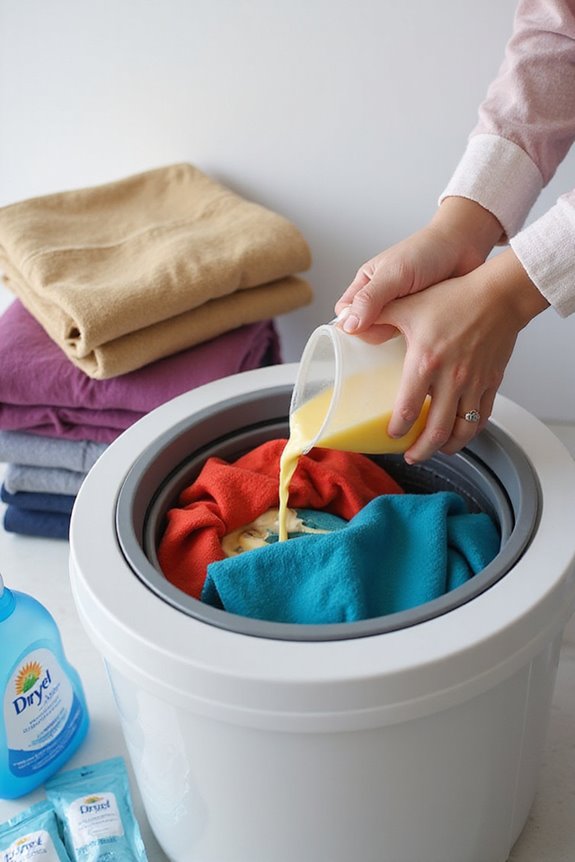
Washing colored clothing properly can make a huge difference in keeping our favorite pieces looking fresh and vibrant. First, let’s sort our clothes by color families: pastels, brights, and darks. This helps reduce color bleeding. We should always wash new dark or bright garments separately at first. Next, we’ll use cold water, below 30°C, to prevent fading and bleeding. Gentle cycles are best for fabric care, so we can preserve our clothes. Remember to turn them inside out before washing to protect the outer surface. Using liquid detergents made for colors is a must, and let’s avoid chlorine bleach. Additionally, choosing detergents designed for dark colors can further enhance color preservation and fabric longevity. With these techniques, we’re investing in color protection and extending the life of our wardrobe!
Drying Recommendations to Preserve Color
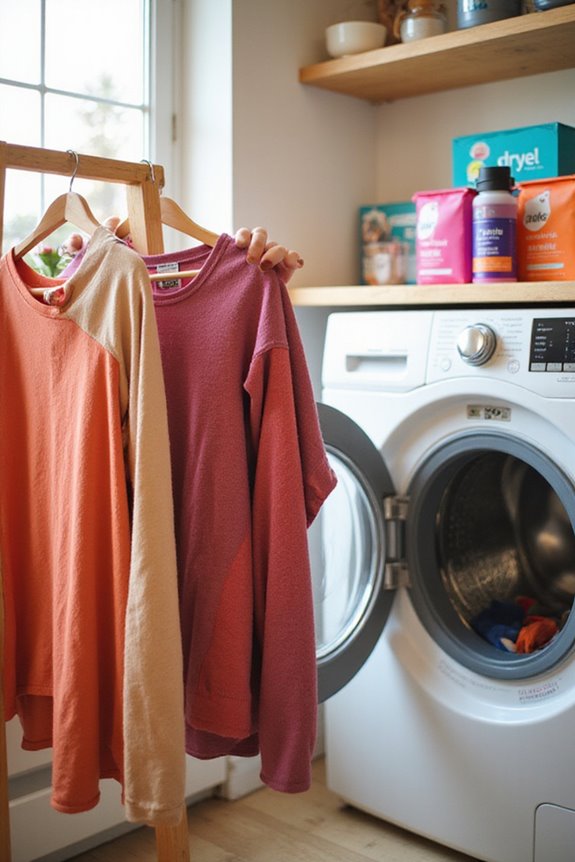
After we’ve mastered the washing techniques for our colorful clothes, it’s time to focus on how we dry them. Air drying is our best friend here! It’s gentle on fabrics, preventing heat damage and color fading. If we hang our clothes in shaded areas, we can dodge those sneaky UV rays that cause fading.
If we must use a dryer, let’s stick to low heat settings. High heat can break down dyes and ruin our vibrant colors. Also, removing clothes while they’re still slightly damp avoids overdrying, which is notorious for causing fading. So, whether we’re air drying or using the dryer, let’s keep our colorful garments looking fresh and fabulous for as long as possible!
Safety Considerations When Using Stain Removers
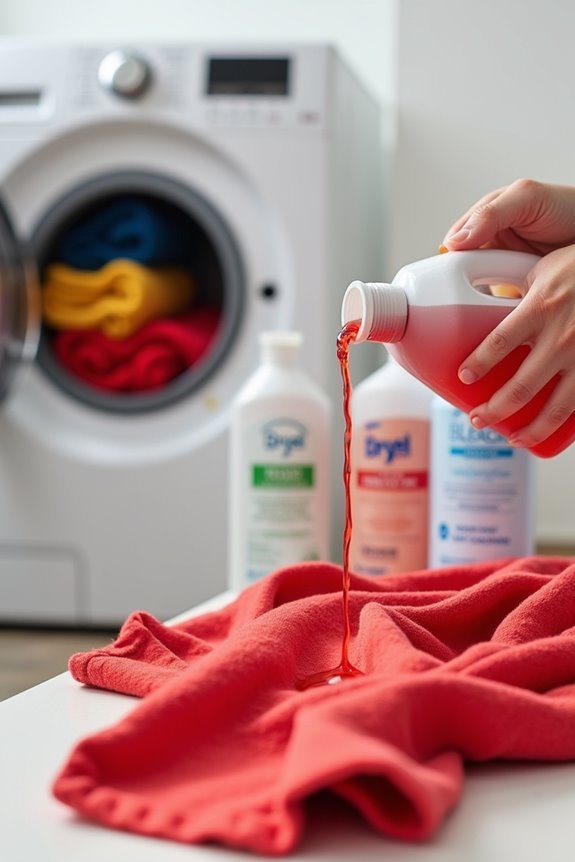
When it comes to using stain removers, we’ve got to be mindful of both our colorful clothes and our health. First, let’s stick to bleach-free options designed for colored fabrics. We don’t want any color fading or damage. Always test a small area for colorfastness before diving in. Remember, mixing different products can lead to harmful chemical interactions, so let’s avoid that! When applying, gently rub the stain without scrubbing too hard. It’s essential to rinse thoroughly afterward to remove any lingering chemicals that could weaken our fabrics over time. And hey, using non-toxic, biodegradable products not only helps our clothes but also keeps our environment happy. Additionally, choosing enzyme-rich detergents can significantly enhance stain removal effectiveness. Let’s treat our clothes—and ourselves—well!
Common Stain Removal Strategies for Colored Fabrics
Stain removers can feel like a magical solution for mishaps on our favorite colored clothes. First, we need to master some stain identification techniques. For example, if we spill coffee, a mix of equal parts white vinegar and water can work wonders. When it comes to ink stains, gently dab with rubbing alcohol using a cotton ball.
Now, let’s not forget our fabric care tips! Always blot stains instead of rubbing, as rubbing can spread them further. After pre-treatment, wash in cold water with an enzyme-based detergent to keep those colors vibrant. Additionally, using a detergent specifically effective for coffee stains can enhance your stain removal process. And remember, testing stain removers on a hidden area first can save our clothes from disaster. With these strategies, we can tackle stains like pros!
Special Care Tips for High-Visibility Clothing
High-visibility clothing is essential for safety, and taking care of it properly can guarantee it lasts longer while keeping us visible. For high visibility maintenance, we should always wash these garments in cold water using a gentle cycle. This helps protect the fabric and reflective tape. Let’s avoid washing them with rough items that could cause damage.
It’s best to turn them inside out and use mild detergents—no bleach or fabric softeners, please! When it comes to drying, line drying is ideal to preserve those bright colors. If we must tumble dry, use the lowest heat setting. Finally, let’s regularly check for wear and tear to assure our gear remains safe and effective. After all, we want to shine bright! Additionally, using detergents designed for synthetic fabrics can enhance the cleaning performance while maintaining the integrity of high-visibility gear.
Testing Stain Removers on Fabric
After taking care of our high-visibility clothing, we might find ourselves facing another challenge: stubborn stains on our favorite colored fabrics. Testing stain removers is essential for ensuring fabric durability and cleaning efficacy. We typically start with cotton or cotton-blend fabric swatches, which are relevant and consistent. Pre-treaters and soakers are applied to mimic real-life scenarios, and then we wash them to see how well each method works. It’s important to check for any fabric damage too. After washing, we assess the results using visual grading or color measurement tools. This way, we understand if a product really works without ruining our favorite shirts. Remember, spot-test before going full-on with a new stain remover!
Environmental Considerations in Stain Remover Use
When we think about cleaning our favorite colored clothes, it’s easy to overlook the impact our stain removers have on the environment. Conventional stain removers often use harsh chemicals that can harm aquatic life. On the flip side, eco-friendly options are designed to minimize this environmental impact. They use renewable ingredients and biodegradable packaging, which help reduce plastic pollution. Plus, many eco-friendly stain removers utilize enzymes that break down stains without harming fabrics or the environment. We’re not just saving our clothes; we’re also protecting our planet! So, next time we reach for a stain remover, let’s consider choosing eco-friendly options. Our clothes—and the Earth—will thank us for it!
Best Practices for Stain Prevention on Colored Garments
To keep our colored clothes looking fresh and vibrant, we need to adopt some smart stain prevention practices. First, let’s sort our laundry by colors—darks, brights, and lights—to prevent dye transfer. Washing colored clothes separately from whites is essential, too. We should use cold or lukewarm water and gentle cycles to preserve vibrancy. When stains happen, we shouldn’t wait; treating them promptly makes removal easier. Blotting stains instead of rubbing is key for avoiding further damage. We can use a vinegar-water mixture for food stains and pre-treat with salt solutions. Also, applying stain repellent sprays can be a great color safeguarding method. These stain prevention techniques can help keep our favorite garments looking their best for longer!
Frequently Asked Questions
Can I Use Homemade Stain Removers on Colored Clothes?
Yes, we can use homemade recipes on colored clothes while ensuring color protection. It’s important to test them first for colorfastness and follow proper application methods to maintain the integrity of our fabrics.
How Do I Know if a Stain Is Colorfast?
Imagine a vibrant sunset; we can check if our colors hold by performing a colorfast test. Simple fabric testing methods reveal if hues will withstand the wash or fade like fleeting daylight.
Are There Specific Stains That Require Professional Cleaning?
Yes, some stains, like oil-based stains and protein stains, often need professional cleaning. They can be tricky and might require specialized treatments to guarantee we don’t damage the fabric during removal attempts.
Can I Mix Different Stain Removers Together for Better Results?
Mixing chemicals might seem like a smart shortcut, but stain remover compatibility is essential. We shouldn’t risk fabric integrity or color fading by blending products. Let’s stick to single solutions for safer, more effective stain removal!
What Should I Do if a Stain Reappears After Washing?
If a stain reappears after washing, we should address stain persistence by refining our washing techniques. Let’s re-treat the stain, avoid drying, and wash again with suitable settings for the best results.



